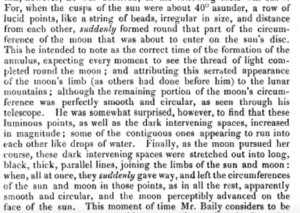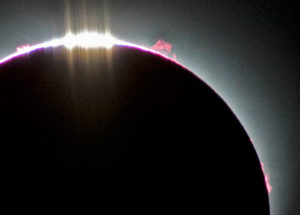It’s a bit of a historical irony that astronomer Francis Baily’s name is attached to the phenomenon of sunlight streaming through the valleys of the moon during a solar eclipse. In 1836, he addressed the Royal Astronomical Society with a description of the phenomenon:

Although the article in the RAS’s Monthly Notices mentions that Baily attributed the effect to “the lunar mountains,” credit for the discovery by no means falls to Baily (as the author of the article observes: Baily “[attributed] this serrated appearance (as others had done before him) to the lunar mountains.”)
The “others” to whom the author’s article refers have to include none other than Edmond Halley. Over 120 years before Baily’s address to the RAS, Halley had already described (and explained) the phenomenon during his famously predicted solar eclipse of 1715, about which he later wrote:
About two Minutes before the Total Immersion, the remaining part of the Sun was reduced to a very fine Horn, whose Extremeties seemed to lose their Acuteness, and to become round like Stars … which Appearance could proceed from no other Cause but the Inequalities of the Moon’s Surface, there being some elevated parts thereof near the Moon’s Southern Pole, by whose Interposition part of that exceedingly fine Filament of Light was intercepted. (cited in Pasachoff 1999, 44, emphasis mine)
Halley, however, was not very well loved, while Baily was quite popular. So, I guess that’s why they’re known as Baily’s beads instead of Halley’s beads.
Here is what they look like (along with some fortuitously located and very pretty red solar flares):

References
NASA. What are Baily’s Beads, and who discovered them? Available at https://eclipse2017.nasa.gov/what-are-baily’s-beads-and-who-discovered-them.
Pasachoff, J. M. Halley and his maps of the Total Eclipses of 1715 and 1724. Available at http://articles.adsabs.harvard.edu//full/1999JAHH….2…39P/0000041.000.html.












